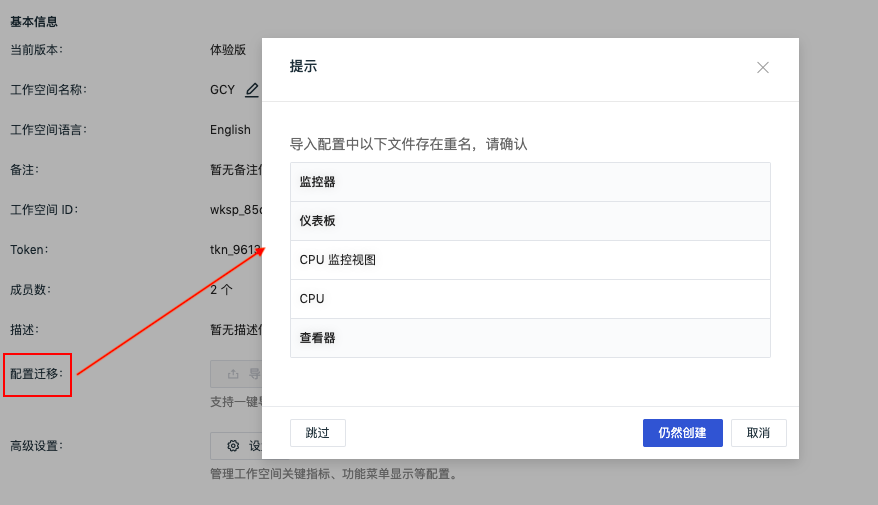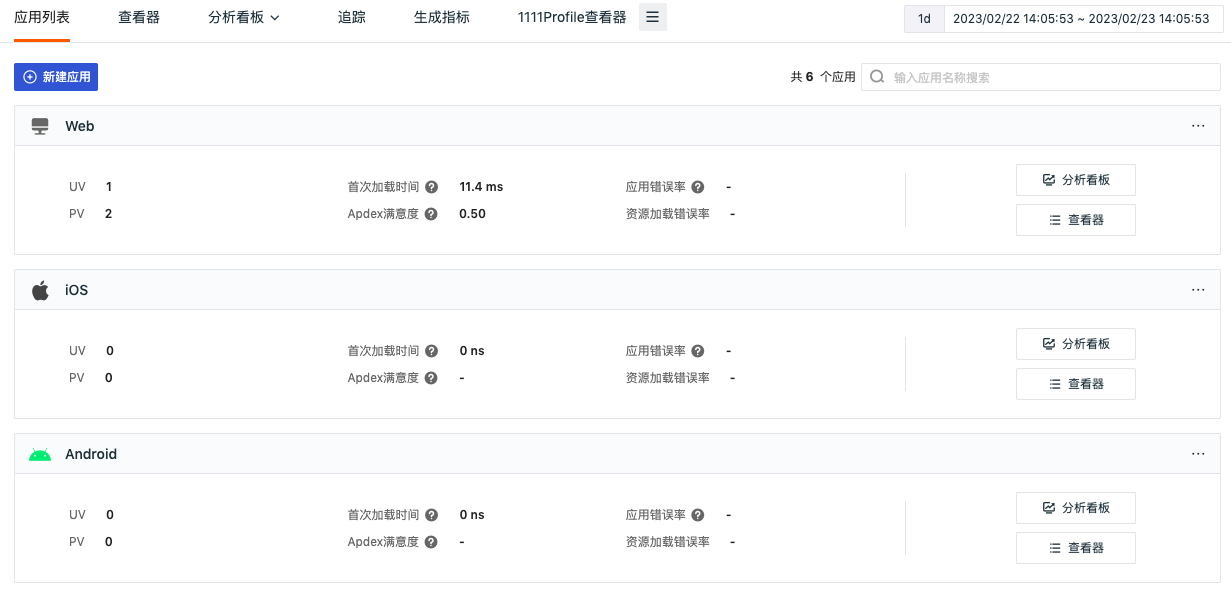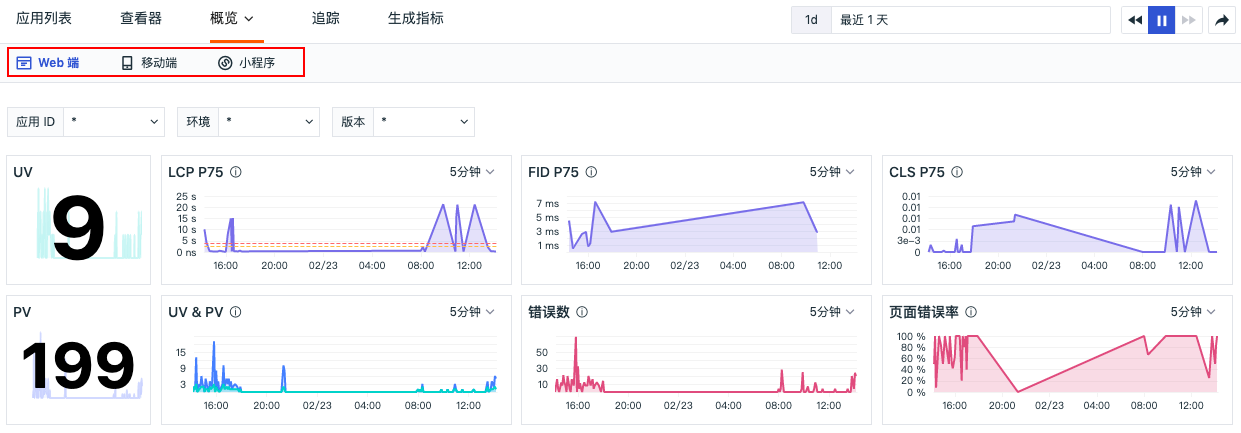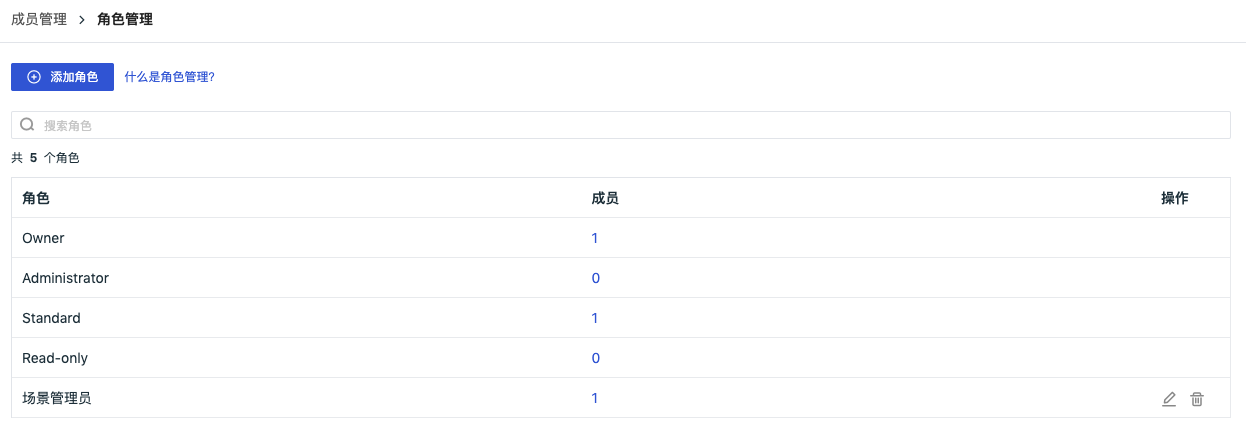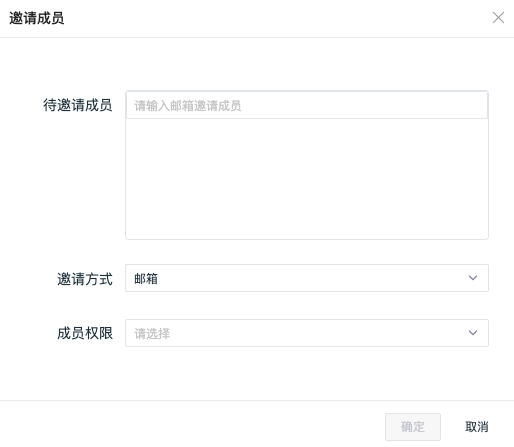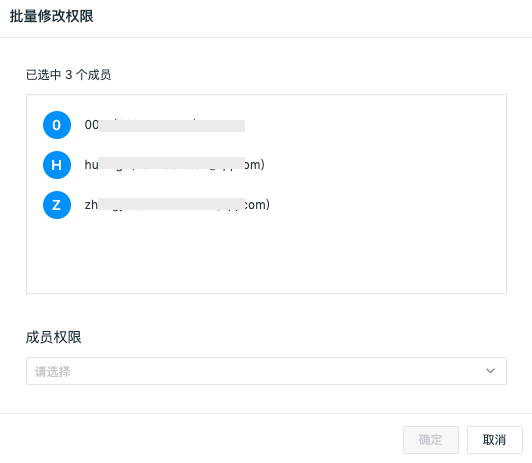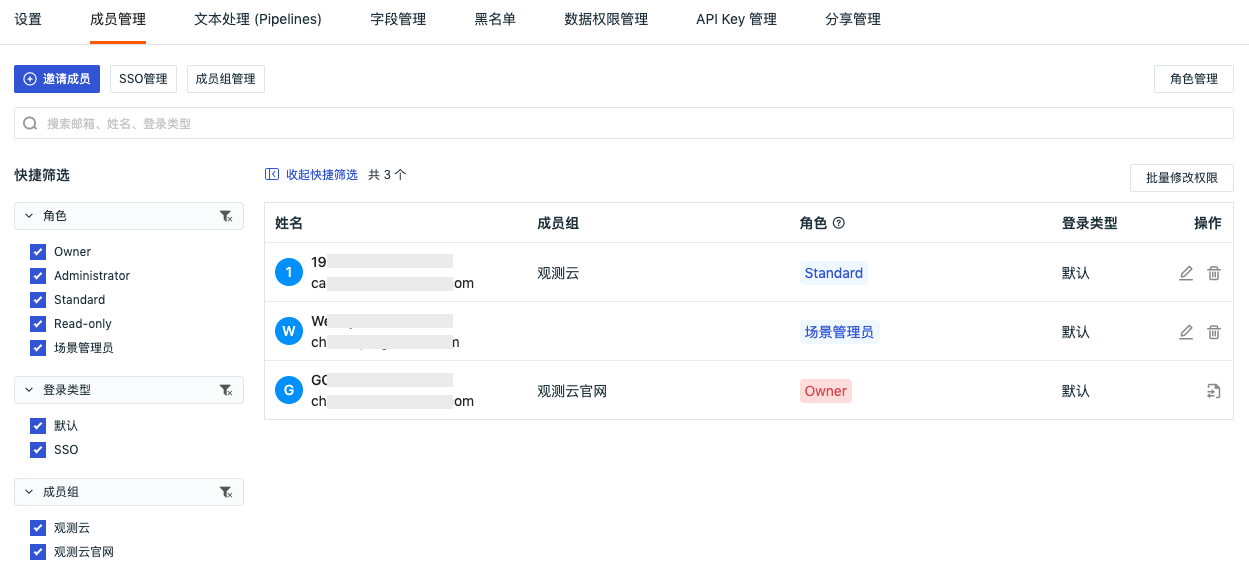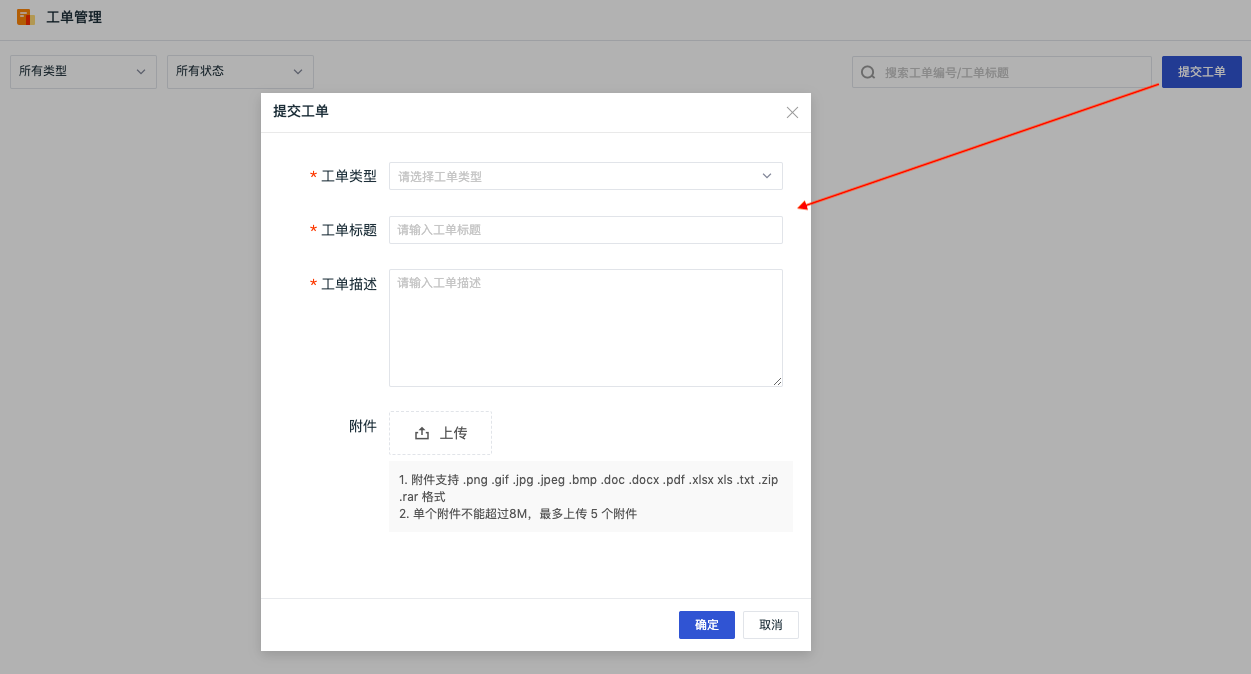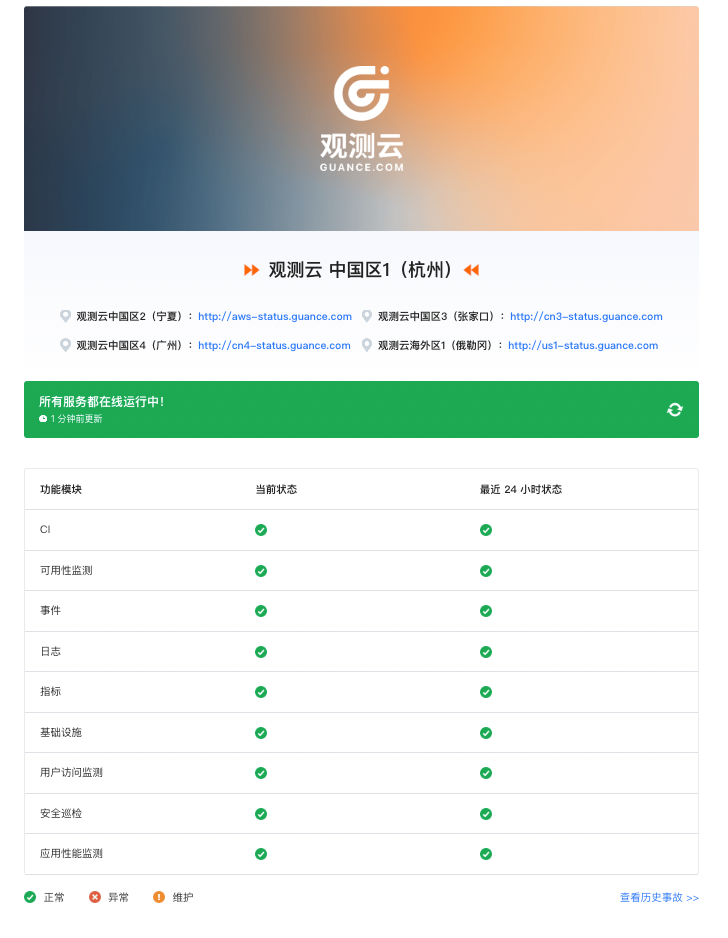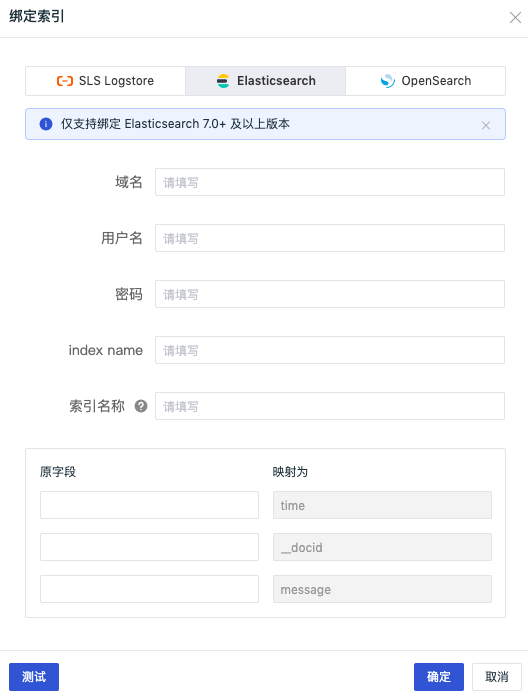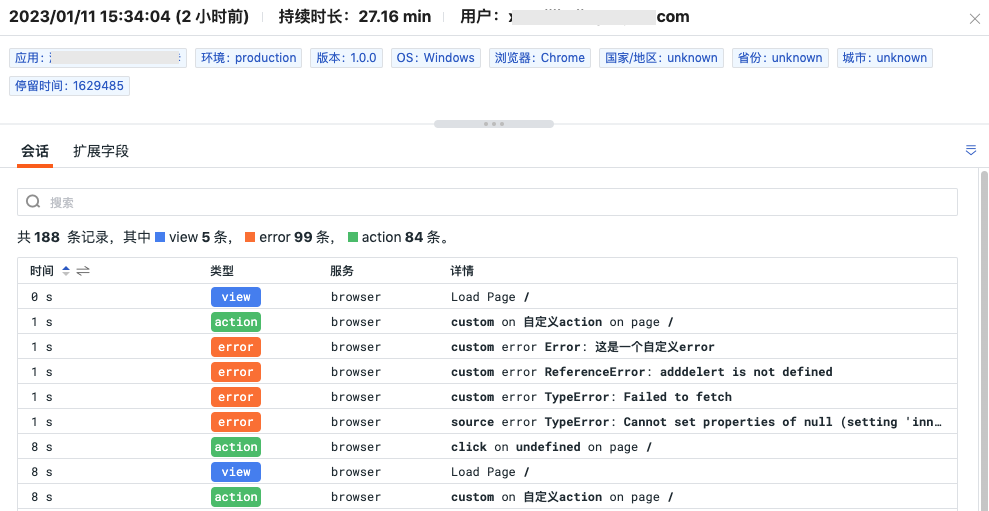Release Notes (2023)¶
This document records the update content of each online release of Guance, including DataKit, Guance best practices, Guance integration documents, and Guance.
December 28, 2023¶
Guance Update¶
- Monitoring:
- Added User Analysis Intelligent Detection: Supports website/APP performance anomaly detection and error analysis; related detection metrics include LCP, FID, CLS, etc.;
- Infrastructure Survival Detection V2: Added a new version of infrastructure survival detection V2, optimized the detection logic, and resolved several triggering issues related to V1 and process detection.
- User Access Monitoring (RUM):
- Added Public DataWay method for receiving RUM data, no need to install collectors; Web applications support directly uploading SourceMap in the console, which can upload multiple files based on different versions and environments.
- Error Viewer > Error Details: Added a formatted error information page, displaying Sourcemap file parsed error information, supporting switching between formatted and raw format error information. If no Sourcemap file is configured or uploaded but not matched, only the raw format error information will be displayed.
- Application Performance Monitoring (APM):
- Optimized Service Map: Adjusted the display styles for upstream/downstream services, nodes, and service names;
- Optimized Service Details: Bound performance view dashboards to display current service performance metrics, also supports updating with custom user views, supports drill-down analysis;
- Optimized Trace Details Flamegraph and Waterfall chart: The flame graph added execution time and execution percentage displays; the waterfall chart supports relative and absolute time switching.
- Chart Optimization:
- Time Series Table Chart Added Display Column Configuration: Supports users setting query data display columns, while supporting user-defined column name input; supports manually adjusting column width in edit mode, saving after adjustment according to column width to display list information; supports dragging to adjust the order of display columns;
- Chart links added Value Variables for use in link redirection.
- Dashboards:
- Dashboards Added Home Dashboard: Supports workspace configuration of home dashboard;
- Infrastructure:
- Host Viewer Added Only Show Online Hosts Switch Filter: Logic for obtaining online host lists has been optimized, supporting choosing whether to only list hosts that have reported data within the last 10 minutes.
Guance Deployment Edition Update¶
- Supports external platforms embedding Guance pages, allowing URL parameters to hide the left and header menus, and supports hiding floating operations;
- Supports external platforms embedding Guance dashboards or viewer pages via iframe.
New Integrations¶
- Added Integration Kubecost
December 14, 2023¶
Guance Update¶
- Monitoring:
- Added Smart Monitoring:
- HOST Smart Detection: Supports CPU spike/drop/interval increase detection, memory spike/drop/interval increase detection;
- LOG Smart Detection: Supports log quantity spike/drop and error log spike detection;
- Application Smart Detection: Supports request quantity spike/drop, error request quantity spike, and request latency spike/drop/interval increase detection.
- Mutation Detection: Added trigger rule prerequisite conditions, performing mutation detection rules when the detected value meets these conditions, improving monitoring accuracy.
- Added Smart Monitoring:
- Billing:
- Added Data Forwarding Usage Analysis List: View the forwarding quantity of all data forwarding rules in the current workspace. If the forwarding rule is to the backup logs module of Guance, it will show the corresponding retention policy. At the same time, it supports filtering the required data forwarding situation list using the time control widget, making it convenient to quickly check the overall backup status of historical logs.
- Events:
- Added Smart Monitoring Event Viewer: Can view all event information generated by smart monitoring.
- Logs:
- Data Access Added [Show Only Related Rules] Configuration: After enabling, only access rules affecting the current account's data queries are shown.
- LOGS > Viewer: Added data access rule restriction prompts.
- Infrastructure > CONTAINERS > Kubernetes:
- Added Kubernetes Analysis Dashboard: Container object analysis dashboard, helping you understand various infrastructure situations in Kubernetes from different dimensions.
- CONTAINERS > Viewer: Page UI optimization.
- Metrics:
- METRICS > Viewer:
- Table charts added [Query Tool] Mode: Return results consistent with Quick Entry > Query Tool; if multiple queries are added, the default returns the first query result; this mode supports exporting up to 1000 query records.
- Added [Copy] Function for Query Conditions, optimizing page experience.
- Query Component Optimization: Simple queries' [by Grouping] supports freely dragging to adjust order.
- METRICS > Viewer:
- Viewer:
- Adjusted all viewers, hiding trend chart display under analysis mode.
- SSO:
- Optimized SSO user workspace listing logic, fixing automatic logout due to lack of access permissions.
Guance Deployment Edition Update¶
- Added Independent Alert Notification Sending Configuration: After enabling this configuration, each event will send an alert notification when the alert strategy selects the [No Aggregation] option, helping you efficiently manage alert notifications.
- Added Event Link Login-Free Viewing Configuration: After enabling this configuration, all event-related links in alert notifications sent by all workspaces can be accessed without logging in. If this configuration is turned off, all previously sent login-free links will become invalid, ensuring data security.
- Optimized [Scheduled Reports]: Supports custom configuration of query ranges, the upper limit increased from 30 days to 360 days, meeting your needs for scheduled report expansion.
New/Updated Integrations¶
- Added APISIX
- Updated Alibaba Cloud Kafka
- Updated Dameng
November 30, 2023¶
Guance Update¶
- Monitoring:
- Create Monitor > Event Content > Insert Link: Supports automatically generating jump links based on detection metrics, allowing adjustments to filter conditions and time range after inserting links; supports customizing jump links.
- Alert Strategy Management: Added [Smart Aggregation] mode, where you can group events within the aggregation cycle based on "Title" or "Content", and each group will generate one alert notification.
- Management:
- Overall style optimization of the module menu page.
- Added [Attribute Claims]: Through fixed fields
organization,business, helps quickly identify and perform joint queries globally. - Added [Regular Expressions]: Can toggle between viewing [Custom] and [Template Library] lists; supports user-defined regular expression templates and applies them to [Snapshot Sharing] and [Data Access Rules].
- Ticket Management:
- Tickets adjusted from "Account Level" to "Workspace Level", all members can view all tickets within the workspace;
- Added [All Tickets] list, [Submitter], and [My Tickets] list.
- Workspace Management: Dissolving workspace operation adds risk confirmation prompt.
- Workspace [Description] function offline handling.
- Data Forwarding: Query and statistics adjustments and optimizations
- Query side: Adjusted content display data range, default shows other data content except
time; - Some robustness optimizations were made for the data forwarding function.
- Query side: Adjusted content display data range, default shows other data content except
- Logs:
- Data Access:
- Added data desensitization rules, supports configuring multiple fields and applying multiple regular expressions;
- Supports configuring all [Indexes] and [Roles];
- Added desensitization preview to determine whether the rules meet the requirements.
- Data Access:
- Snapshot > Share Snapshot:
- Share link validity period added 1, 3, 7 days options, default selected as 1 day;
- Data desensitization: Supports configuring multiple fields and applying multiple regular expressions;
- Supports snapshot preview, you can view all configured page effects in advance.
- RUM: [Create Application] page layout adjustment, optimizing user experience.
- Pattern:
- RUM > Error Viewer & APM > Error Tracing: Under pattern analysis mode, changed to
drain()algorithm aggregation logic; added input box to modify cluster fields, default iserror_message, up to 3 fields can be entered, and customized cluster fields can be defined as needed.
- RUM > Error Viewer & APM > Error Tracing: Under pattern analysis mode, changed to
Guance Deployment Edition Update¶
- Added support for customizing email headers and footers as well as Logo display text;
- Guance will cancel Banner information settings and no longer provide relevant support for maintaining Banner information.
New Integration¶
- Added logstash
New Best Practices¶
- Incident and JIRA Bidirectional Linkage Best Practices
November 21, 2023¶
Guance Update¶
- Management: Added MFA Security Authentication switch on the [Settings] page. Once the administrator/owner enables this feature, all users (regular members / SSO members) must complete MFA authentication before entering the space.
Guance Deployment Edition Update¶
- Added MFA Security Authentication switch, supporting identity verification through system default or custom methods.
November 16, 2023¶
Guance Update¶
- Monitors:
- [Alert Mute] functionality restored, still configurable via alert mute to define the interval for repeated alert notifications.
- Removed the restriction that at least one of "Urgent", "Important", or "Warning" trigger conditions must be configured, now supports configuring any one of Urgent, Important, Warning, Data Outage, Information triggers.
- Infrastructure Survival Monitoring: Supports metric configuration for infrastructure survival detection, defining higher frequency survival detection configurations through this mode.
- Scenarios
- Charts:
- Advanced Settings: [Original Interval] parameter configuration offline, default configuration adjusted to [Automatic Alignment], supports custom selection of time intervals for chart data under default circumstances.
- Time Series Chart: [Display Density] adjusted to [Maximum Returned Points], default value is 720, supports defining any integer between 2-1000.
- Fixed the issue causing alias functionality to fail after PromQL linked view variables.
- Service Management:
- Added built-in dropdown switcher, allowing direct selection of services without returning to the service list.
- Detail page POD page retired.
- [Resource Calls] performance chart changed to a combination chart display, optimizing page presentation.
- Charts:
- Management
- SSO Management:
- When logging in via SSO, the workspace supports listing all authorized workspaces under the current [Identity Provider ID]; supports locating target workspaces directly via [Search] functionality.
- [User SSO] Added [Import/Export] functionality, facilitating quick configuration of SSO for multiple workspaces.
- Workspace Language:
- Default language display logic for the console adjusted, default following browser language configuration.
- When modifying workspace language version, event, alert, SMS, etc., notification templates will also use the modified language template.
- SSO Management:
- Incident correlation with Incident Tracking added linkage markers:
- Unresolved incident list allows understanding whether the current incident is associated with a certain incident tracking via icon.
- Incident Tracking: If there are events synchronized and created by monitors, they can quickly understand the number of associated events via icon.
- Infrastructure > HOST: Optimized inaccurate sorting of indicator data in the HOST viewer.
- Several Pipeline usage experience optimizations:
- Added a notice in the data source selection column for Pipeline scripts already configured;
- Log data sample selection added "Index" selection, solving the problem of users not using the default index leading to inability to obtain sample data.
Guance Deployment Edition Update¶
- Single Sign-On: Supports appending phone number information dynamically based on returned user information when user accounts log in via OIDC.
New Integrations¶
- Added argocd, fluentd, redis-sentinel
November 9, 2023¶
Guance Update¶
- Monitors > Alert Strategy Management:
- Notification Configuration: Changed to configure single or multiple notification objects for individual abnormal levels.
- Recovery Notification Logic Change: When historical abnormal alert events recover, Guance sends recovery notifications to corresponding notification objects.
- Added [Alert Aggregation]: Supports configuring alert notification aggregation based on rules. There are two aggregation modes:
- No Aggregation: In this mode, alerts are merged every 20 seconds and sent to corresponding notification objects;
- Rule Aggregation: You can choose four aggregation rules and send alert notifications based on the aggregation cycle.
- Added [Aggregation Cycle]: In rule aggregation mode, events within 1-30 minutes will be aggregated into notifications, and events exceeding the aggregation cycle will be aggregated into new alert notifications.
- Management > Data Forwarding: Supports custom time range queries, allowing selection of multiple dates and definition of start and end times.
November 2, 2023¶
Guance Update¶
- Management:
- SSO Management: Supports OIDC / Oauth2.0 Protocol Single Sign-On Configuration;
- Data Permission Management: Adds [Role] during authorization configuration. After configuring roles, the authorized workspace will restrict data query access and desensitization based on the selected role scope.
- Data Forwarding:
- Navigation position moved to the [Management] module, still accessible via the secondary menu of [Logs], [User Access Monitoring], [Application Performance Monitoring];
- AWS S3 and Alibaba Cloud OSS support "Cross-Account Authorization" configuration, enabling mutual authorization between two accounts, simplifying the configuration process.
- Billing:
- Supports data forwarding to Guance internal storage, calculating the size of data stored daily in Guance storage objects;
- Events > Unresolved Events:
- Currently, the unresolved events list retains event data from the past 24 hours;
- Added display preference: default displays [Standard] mode, supports selecting [Extended] mode to open historical trends of event detection results;
- Supports exporting the current event list to CSV;
- Event details page added Extended Fields Tab; base attribute Tab page interface optimized.
- Infrastructure > NETWORK:
- Optimized [Overview] template, added quick filters, allowing users to filter network paths. Added 5 statistical charts, supporting analysis of sent/received bytes, TCP retransmissions, and other network metrics;
- Added [Network Flow] Viewer, allowing viewing all L4(netflow), L7(httpflow) network flow data on the timeline;
- Other Viewer detail pages added [Topology] mode display, allowing direct viewing of current object’s upstream/downstream network relationships and some key network indicators.
- Scenarios:
- View Variables: Support adding PromQL Queries;
- Charts:
- For Doris data storage workspaces, added [Data Sampling];
- Time auto-alignment function optimization: For all metrics data and Doris data charts, when the time auto-alignment function is enabled, the returned data timestamps will align by "whole second/whole minute/whole hour";
- Leaderboard, Overview chart, Table chart: Added [Rule Mapping], allowing configuration of corresponding font color/background color for data within mapped value ranges.
- Viewer: Analysis mode optimization, supporting free aggregation queries based on data and displaying analysis in chart form;
- Service Management > Resource Calls: Resource leaderboard added [Requests Per Second] option.
- Synthetic Tests > Tasks: Supports import/export.
- Doris LOG data engine does not yet support
with_labelslinked queries.
Guance Deployment Edition Update¶
- Supports custom configuration of session expiration duration, uniformly setting Login Session Persistence Duration for front-end users.
October 19, 2023¶
Guance Update¶
- Billing: The billing item [Data Forwarding] statistic logic changed to "data forwarding rules" for counting forwarded data volumes.
- Management
- SSO Management: Supports creating multiple SSO IDP configurations, and enabling/disabling operations for individual IDPs, initiating SAML mapping.
- Data Permission Management > Sensitive Data Desensitization: Supports configuring sensitive data masking rules at the role level, using regular expression desensitization during configuration, supporting field-level desensitization rule configuration for specific data types, and adding desensitization rule preview testing.
- Monitors: Added External Event Detection, sending third-party system abnormal events or records to HTTP server via POST requests to generate Guance event data.
- Scenarios
- Service Management > Resource Calls: Added quantity sorting for corresponding lists, default sorting descending;
- Chart Links: Added start time and end time parameters for currently selected data points, variables being
#{timestamp.start}and#{timestamp.end}; - Chart Aliases: Configured based on legend sequence;
- Table Chart: Added [Time Series Table Chart].
- METRICS > Metric Analysis: Table chart added [Time Series Mode].
Guance Deployment Edition Update¶
- Added Custom Mapping Rule Configuration: After enabling this configuration, corresponding workspaces can customize mapping rules. Workspace custom mapping rules take precedence over backend management mapping rules;
- Added Query Quantity Limit: Different user workspaces have customized limits to avoid low cluster query performance due to excessive query data volume, impacting product usability;
- Local accounts added password change.
Integration Updates¶
- Incident Event and PagerDuty Linkage: When our application or system encounters an abnormality, timely handling is usually required to ensure normal system operation. To better manage and track abnormal events, we can send these events to PagerDuty to create incidents, thus enabling us to track, analyze, and resolve these issues within PagerDuty. By quickly sending abnormal events to PagerDuty to create incidents, it provides us with better capabilities for managing and tracking abnormal events, thereby ensuring better system operation. Simultaneously, this method can also help us better analyze and solve problems, enhancing system stability and reliability.
September 26, 2023¶
Guance Update¶
- Scenario > Service Management: Added [Upstream/Downstream Topology] component to resource calls, allowing users to view upstream/downstream resource call relationships for current resources.
- Logs > Data Forwarding: Data forwarding rules support RUM, APM data.
September 21, 2023¶
Guance Update¶
- Logs:
- Data Forwarding: Added external storage forwarding rule data query; supports enabling/disabling forwarding rules;
- Index Binding: Added tag binding for log easy, enabling finer-grained data range query authorization.
- Infrastructure > Custom:
- Changed concept of [Default Attributes] to [Required Attributes]: Reported data must contain this attribute field, otherwise reporting will fail;
- Supports adding resource catalogs to the secondary menu for easier viewing.
- Custom Viewer added quick filtering.
- Scenarios:
- Scheduled Reports: Added [DingTalk], [Enterprise WeChat], [Lark] three notification methods;
- Charts: [Time Series Chart, Pie Chart, Bar Chart, Histogram, Scatter Plot, Bubble Chart, Table Chart, Rectangle Tree Chart, Funnel Chart, Leaderboard, Map, Honeycomb Chart] added data formats, allowing definition of [Decimal Places] and [Thousands Separator].
- Monitoring > Notification Targets Management: Email group type deprecated, existing ones unaffected.
- Snapshots: Shared Snapshots: Added IP whitelist access restrictions.
- Incident Tracking: [Level] supports custom creation; supports enabling/disabling default levels.
- Integration > Extensions: DataFlux Func (Automata) and RUM Headless now support overseas sites: Oregon, Frankfurt, Singapore.
Integration Updates¶
Huawei Cloud:
-
Huawei CCE: Guance supports monitoring various resources in Huawei CCE, including Containers, Pods, Services, Deployments, Clusters, Nodes, Replica Sets, Jobs, Cron Jobs, etc. You can install
DataKitvia DaemonSet in Kubernetes to collect data from Kubernetes resources. Eventually, Guance monitors the real-time operating status of various Kubernetes resources. -
Huawei CSS (Elasticsearch): Core performance indicators for Huawei Cloud Search Service CSS for Elasticsearch include query latency, indexing speed, search speed, disk usage, and CPU usage, all critical for assessing and optimizing Elasticsearch performance.
-
Huawei SYS.AS: Core performance indicators for Huawei SYS.AS include CPU utilization, memory usage, disk I/O, network throughput, and system load, all critical for assessing and optimizing auto-scaling system performance.
-
Huawei ASM: Huawei Cloud ASM trace data output to Guance for viewing and analysis.
AWS:
-
AWS CloudFront: Core performance indicators for AWS CloudFront include total requests, data transfer, HTTP error rate, cache hit rate, and latency, helping users evaluate and optimize CDN performance.
-
AWS MediaConvert: Includes data transfer, video errors, job count, padding, etc.
-
AWS Aurora Serverless V2: Includes connection count, IOPS, queue, read/write latency, network throughput, etc.
-
AWS Redshift: Core performance indicators for AWS Redshift include query performance, disk space usage, CPU utilization, database connections, and disk I/O operations, all critical for evaluating and optimizing data warehouse performance.
-
AWS Simple Queue Service: Displayed indicators include the approximate existence time of the oldest undeleted message in the queue, the number of delayed messages that cannot be immediately read, the number of messages in flight, and the number of messages retrievable from the queue.
-
AWS Timestream: Displayed indicators include system error count (internal service errors), the total of invalid requests for the current AWS region and current AWS account, the elapsed time and sample count of successful requests, the amount of data stored in memory, and the amount of data stored in magnetic storage.
-
AWS Neptune Cluster: Displayed indicators include cold start time, execution time, concurrent executions, and memory usage, reflecting Neptune Cluster function response speed, scalability, and resource utilization.
September 7, 2023¶
Guance Update¶
- Scenario > Dashboard/Viewer: Added global cross-workspace query configuration.
- Scenario > Chart Query: When time widget range is less than or equal to [Last 15 Minutes], automatically aligned time interval added "1 second" display.
- Scenario > Service Management:
- Service list added binding multiple built-in views to analysis dashboards; added associations and team information;
- Added resource call analysis dashboard;
- Supports saving snapshots.
- Logs > Backup Logs:
- Officially changed to Data Forwarding;
- Added trace, user access data sources;
- Original backup log billing item renamed to data forwarding billing item.
- Logs > Viewer: Added entry point for creating monitors; supports saving snapshots for detailed viewer pages.
- Management:
- Global Labels: Added global label function, managing labels uniformly;
- Field Management: Added aliases, set display columns;
- Workspace Management: Functional consolidation and interface optimization;
- Member Management: Original member group definition officially changed to team;
- Sensitive data scanning: Added scan rule count statistics; added jump link.
- Monitoring:
- Synthetic Testing Anomaly Detection: Added test metrics, allowing detection based on [Metrics] dimension;
- Mutation, outlier, interval detection: Supports selecting all data sources.
Integration Updates¶
Alibaba Cloud:
- aliyun_analyticdb_postgresql: Alibaba Cloud AnalyticDB PostgreSQL metric display, including CPU, memory, disk, coordinator node, instance queries, etc.
- aliyun_clickhouse_community: Alibaba Cloud ClickHouse metric display, including service status, log traffic, operation count, overall QPS, etc.
- aliyun_kafka: Alibaba Cloud
KafKaincludes message throughput, latency, concurrent connections, and reliability, reflecting Kafka's performance and reliability in handling large-scale messaging and real-time data streams. - aliyun_lindorm: Includes high-throughput, low-latency data read/write capabilities, supports high-concurrency transaction processing, and offers strong consistency and highly reliable data storage and query services.
- aliyun_polardb_1.0: Alibaba Cloud PolarDB distributed 1.0 displayed metrics include CPU utilization, memory utilization, network bandwidth, and disk IOPS.
- aliyun_polardb_2.0: Alibaba Cloud PolarDB distributed 2.0 displays compute layer and storage node metrics, including CPU utilization, connection usage, disk usage, disk utilization, memory utilization, network bandwidth, etc.
- aliyun_rds_postgresql: Alibaba Cloud RDS PostgreSQL metric display, including CPU usage, memory usage, etc.
- aliyun_rocketmq5: Alibaba Cloud RocketMQ 5.0 displayed metrics include message throughput, latency, reliability, and horizontal scaling capabilities, etc.
AWS:
- aws_dynamodb_DAX: AWS DynamoDB DAX displayed metrics include CPU usage for nodes or clusters, bytes received or transmitted on all network interfaces, packet counts, etc., reflecting DynamoDB DAX operational status.
- aws_memorydb: AWS MemoryDB core performance metrics include low-latency memory read/write capability, high-concurrency transaction processing capability, and linearly scalable storage capacity and throughput.
Huawei Cloud:
- huawei_functiongraph: HUAWEI FunctionGraph displayed metrics include invocation count, error count, rejected count, concurrency, reserved instance count, runtime (including maximum runtime, minimum runtime, average runtime), etc., reflecting FunctionGraph function execution status.
- huawei_kafka: Includes message throughput, latency, concurrent connections, and reliability, reflecting Kafka's performance and reliability in handling large-scale message transmission and real-time data streams.
- huaweiyun_SYS_DDMS: 'Huawei Cloud SYS.DDMS monitoring view displayed metrics include message throughput, latency, concurrent connections, and reliability, reflecting DDMS's performance and reliability in handling large-scale message transmission and real-time data streams.
Tencent Cloud:
- tencent_keewidb: Tencent Cloud KeeWiDB metric display, including connection count, requests, cache, keys, slow queries, etc.
- tencent_mariadb: Includes high-performance read/write capability, low-latency query response time, and support for high-concurrency transaction processing and scalability.
- tencent_memcached: Includes high-speed memory read/write capability, low-latency data access time, and high-concurrency access processing capability.
- tencent_tdsql_c_mysql: Includes high-throughput read/write capability, low-latency query response time, and support for high-concurrency transaction processing and scalability.
Others:
- openai: OpenAI displayed metrics include total requests, response time, request count, request error count, and consumed token count.
- monitor_jira: When our application or system encounters an abnormality, timely handling is usually required to ensure normal system operation. To better manage and track abnormal events, we can send these events to Jira to create incidents, thus enabling us to track, analyze, and resolve these issues within Jira. By quickly sending abnormal events to Jira to create incidents, it provides us with better capabilities for managing and tracking abnormal events, thereby ensuring better system operation. Simultaneously, this method can also help us better analyze and solve problems, enhancing system stability and reliability.
August 29, 2023¶
Guance Update¶
- Scenario > SLO Chart: Added fault time display.
- Deployment Edition: Management backend Mapping Rules added application compatibility rules only for newly added members, enabling the mapping rules when this option is selected to apply only to first-time joining members.
August 24, 2023¶
Guance Update¶
- Billing Items:
- Backup Logs: Added four archiving type billing items OSS, OBS, AWS S3, Kafka, aggregating forwarded traffic sizes based on user-selected archiving types and billing accordingly;
- Application Performance Trace, User Access PV added 30-day/60-day data storage policies.
- Monitoring:
- Mute Rules: Supports configuring alert silencing based on different dimensions.
- Monitors: Supports adding tags to monitors, filtering lists by tags; added quick filter columns to monitor lists and optimized the list;
- SLO: Added Fault Time display column.
- Logs > Backup Logs: Added Kafka Message Queue external storage.
- Viewer/Dashboard: Added Auto Refresh Function.
- Viewer Details Page: Added Bind Built-in View entry.
Integration Updates¶
- Alibaba Cloud RDS MariaDB: Alibaba Cloud RDS MariaDB displayed metrics include response time, concurrent connections, QPS, and TPS.
- Alibaba Cloud RocketMQ4: Alibaba Cloud RocketMQ 4.0 displayed metrics include message throughput, latency, reliability, and horizontal scalability.
- Alibaba Cloud Tair Community Edition: Alibaba Cloud Tair Community Edition metrics displayed include CPU usage, memory usage, proxy total QPS, network traffic, hit rate, etc.
- AWS DynamoDB: AWS DynamoDB displayed metrics include throughput capacity units (Capacity Units), latency, concurrent connections, and read/write throughput, reflecting DynamoDB's performance and scalability in handling large-scale data storage and access.
- AWS EventBridge: AWS EventBridge displayed metrics include event delivery latency, throughput, event scale, and scalability, reflecting EventBridge's performance and reliability in handling large-scale event streams and real-time data delivery.
- AWS Lambda: AWS Lambda displayed metrics include cold start time, execution time, concurrent executions, and memory usage, reflecting Lambda functions' response speed, scalability, and resource utilization.
- HUAWEI SYS.AS: HUAWEI SYS.AS displayed metrics include response time, concurrent connections, throughput, and reliability, reflecting SYS.AS's performance and stability in handling application requests and data interactions.
- HUAWEI SYS.CBR: HUAWEI SYS.CBR displayed metrics include bandwidth utilization, latency, packet loss rate, and network throughput, reflecting CBR's performance and quality assurance in network transmission and bandwidth management.
- Huawei Cloud GaussDB-Cassandra: Huawei Cloud GaussDB-Cassandra displayed metrics include read/write throughput, latency, data consistency, and scalability, reflecting GaussDB-Cassandra's performance and reliability in handling large-scale distributed data storage and access.
- Huawei Cloud GaussDB for MySQL: Huawei Cloud GaussDB for MySQL displayed metrics include response time, concurrent connections, read/write throughput, and scalability, reflecting GaussDB for MySQL's performance and reliability in handling large-scale relational database operations.
- Huawei Cloud GaussDB-Influx: Huawei Cloud GaussDB-Influx displayed metrics include write throughput, query latency, data retention policy, and scalability, reflecting GaussDB-Influx's performance and reliability in handling large-scale time-series data storage and querying.
- Huawei Cloud GaussDB-Redis: Huawei Cloud GaussDB-Redis displayed metrics include read/write throughput, response time, concurrent connections, and data persistence, reflecting GaussDB-Redis's performance and reliability in handling high-concurrency data storage and caching.
- Huawei Cloud GaussDB SYS.GAUSSDBV5: Huawei Cloud GaussDB
SYS.GAUSSDBV5, providing CPU, memory, disk, deadlock,SQLresponse time data. - Huawei Cloud MongoDB: Huawei Cloud MongoDB displayed metrics include read/write throughput, latency, concurrent connections, and data reliability, reflecting MongoDB's performance and scalability in handling large-scale document storage and querying.
- Huawei Cloud RDS PostgreSQL: Huawei Cloud RDS PostgreSQL displayed metrics include query performance, transaction throughput, concurrent connections, and data reliability, reflecting RDS PostgreSQL's performance and reliability in handling large-scale relational data storage and transaction processing.
- Tencent Cloud CKafka: Tencent Cloud CKafka displayed metrics include message throughput, latency, concurrent connections, and reliability, reflecting CKafka's performance and reliability guarantee in handling large-scale message transmission and real-time data streams.
- Zadigx: Zadigx displays including overview, automated builds, automated deployments, automated tests, etc.
- Lark and Incident Tracking Integration: To conveniently and promptly receive new Issues from Incident Tracking, you can create a robot in internal groups on Lark, DingTalk, or WeCom to accept reminders for new Issues or replies in Incident Tracking, helping to handle Issues promptly; you can also quickly reply to Issues by mentioning the robot, improving the efficiency of handling anomalies.
August 17, 2023¶
Guance Update¶
- Management: Added Sensitive Data Scan function: Achieving information masking by creating desensitization rules for data.
- Added billing item: Sensitive Data Scan Traffic: Based on scan rules, it statistically calculates the original traffic size of scanned sensitive data (per GB/day).
- Billing: The consumption analysis section was temporarily removed due to renovation and optimization.
August 10, 2023¶
Guance Update¶
- Added billing item:
- Scheduled Report: Billed based on the number of scheduled reports sent per day within the workspace;
- Scenario:
- Added *Service Management*: Service Management is a centralized entry point for accessing all critical service information, allowing users to view the performance and business data of different services within the current workspace and all related analyses, quickly identifying and resolving service-related issues.
- All charts support PromQL queries and expression queries.
- Logs: Supports directly viewing context logs on the log details page; selectable context search range.
- Viewer: Opening a data details page supports exporting the current data as a JSON file with one click.
- Application Performance Monitoring > Service > Call Topology: Added tables showing upstream/downstream call relationships for the current service, displaying the number of requests, average response time, and error counts for unidirectional service relationships.
- Monitors > Threshold Detection: Added Convert to PromQL Query for detection metrics.
- Infrastructure > CONTAINERS: Added Kubernetes Events component to the details pages of Pods, Services, Deployments, Nodes, Replica Sets, Cron Jobs, Daemonset.
July 27, 2023¶
Guance Update¶
- Scenario > Dashboard: Added Scheduled Report Function, supporting users creating reports based on a specific dashboard and configuring timed email sending.
- Navigation bar added *Invite Members* entry, allowing quick invitations of members through this entry. In the management page, added an Approval Invitation button. When this button is enabled, after sending an invitation to a member, approval management of the member's join application must be moved to the invitation record.
- Logs > Backup Logs have the following adjustments:
- Guance default archiving type offline:
- Newly created backup rules will no longer support the [Guance] default option;
- Historically created backup rules remain effective.
- Added support for backing up to external storage Alibaba Cloud OSS.
- Guance default archiving type offline:
- Monitoring > Create: Supports saving monitors as Custom Template Libraries, enabling subsequent users to quickly create similar monitor detections.
- Monitoring > Create Monitor > Custom Create: Except for [Mutation Detection][Interval Detection][Outlier Detection], all detection rules' detection frequencies added [Last 12 Hours][Latest 24 Hours] options.
- *Incident Tracking: Added **Delivery Channel configuration entry on the New Issue page, supporting multi-selection; added *Unknown** option to level, default selected.
- To meet user data compliance requirements, Snapshots support desensitization of certain contents via regular expression syntax for fields.
- Scenario > Log Stream Diagram added Copy as cURL, export as CSV file function.
- User Access Monitoring > Viewer > Error: Added *Cluster Analysis* function, making it convenient to view frequently occurring errors.
- Added data limit prompt: i.e., if the log, trace, etc., data reaches today's limit, data reception will stop. Contact your customer manager for adjustments if needed.
July 11, 202- Integration Upgrade: Clicking any integration solution allows you to understand the full chain usage solution from configuration access, data collection to data application on the same page.¶
- *Monitor > Template* Function Optimization: Supports creating or batch creating based on a single detection rule; supports filtering based on the detection library.
- Application Performance Monitoring > Trace: Span List page added Waterfall Chart Mode, helping users analyze Span data information more intuitively; *Service Call Relationship* changed from service (service) level to service resource (service / resource) level, enabling better analysis of corresponding performance and call issues by drilling down to the interface level, thus helping users identify problem points faster through interface-level calls.
- *Charts > Overview Chart: Added thousand separator; in **Units > Values, “Default” changed to “Ten Thousand System”; added empty value mapping in *Value Mapping**.
- *Charts > Rectangle Tree Chart*: Added display value options, selecting which can directly display query result values in the chart.
- *Charts > Add Link*: Added
queryparameter, deletedtags,searchtwo parameters. - Application Performance Monitoring > Service list supports export.
Intelligent Inspection Update¶
Function Optimization:
- Application Performance Inspection: Added default detection threshold change entry, now when starting inspections, you can simultaneously modify the trigger values for services that need to be detected.
- RUM Performance Inspection: Optimized root cause display logic in the page details module, making root cause positioning more accurate after optimization.
- Workspace Asset Inspection: Added default configuration (7 days), now starting inspections does not require parameters to run.
New Scripts:
- Cloud Message Queue RocketMQ4.0
- Huawei Cloud-CSS
- Huawei Cloud-RocketMQ
- Huawei Cloud-RabbitMQ
- Huawei Cloud-WAF-Event List
- Huawei Cloud-WAF-Event Overview
June 29, 2023¶
Guance Update¶
This update simplifies the registration process:
- International Guance Product Service officially launched, users can purchase it on AWS overseas cloud market.
-
International Guance product adopts dollar-based pricing system. Data for workspaces originally registered at the Oregon site on the China station will be billed according to the adjusted price.
-
The concept of Guance Corporate Account has been officially changed to Billing Center Account;
Other updates:
- Snapshot Permissions: Read-only members support creating and deleting snapshots visible only to themselves.
June 20, 2023¶
Guance Update¶
- RUM (Real User Monitoring) collector is used to collect user access monitoring data reported from web pages or mobile ends. Now provides RUM Headless one-click activation service, achieving automated installation and deployment on Guance cloud hosts, automatically completing DataKit installation and RUM collector deployment. Only manual application connection is required.
- Viewer: Optimized filtering, search interaction conversion logic, allowing users to truly achieve what-you-see-is-what-you-get, and enabling free switching between UI and handwritten modes. Additionally: DQL handwritten mode supported by the log viewer will be discontinued after the new version goes online.
- Logs > Backup Logs: Added external storage type selection, supporting writing to S3(AWS) object storage and Huawei Cloud OBS data writing.
- Logs > Index: Added Log Easy data binding configuration entry.
- Dashboards/Built-in Views support Root Cause Analysis and Drill-down Analysis.
- Management > Role Management: Supports Cloning Existing User Roles to reduce operational steps, quickly adding/removing permissions and creating roles.
- Infrastructure > CONTAINERS: Added Daemonset Object Data display, allowing drag-and-drop changes to object classification display order.
- Infrastructure > CONTAINERS: Deployments, Pods support direct association with Kubernetes event logs, allowing specific log information to be viewed directly on the details page.
- Added Incident Tracking OpenAPI Interface.
- Management > Member Management list, Monitoring > Notification Targets Management > Email Groups, Incident Tracking > View Members, all notification target selections support searching by member nickname.
- When the status of a ticket is updated or there are new replies, customers are reminded via the interface or email.
- Input box input invalid character or length restriction prompt optimization.
Intelligent Inspection Update¶
-
New Inspection
- AWS Cloudtrail Abnormal Event Inspection: AWS CloudTrail is a service used for tracking, logging, and monitoring AWS account activities. It records operations performed within the AWS account, including management console access, API calls, resource changes, etc. By monitoring CloudTrail's error events, potential security issues can be promptly identified. For example, unauthorized API calls, denied access to resources, abnormal authentication attempts, etc. This helps protect your AWS account and resources from unauthorized access and malicious activities; also enables understanding the types, frequency, and impact range of failures occurring in the system. This helps quickly identify problems and take appropriate corrective measures to reduce downtime and business impact.
-
New Script
- Guance Integration (Alibaba Cloud-RDS Error Logs): Collects Alibaba Cloud RDS error logs for RDS error information diagnostics;
- Filebeats Data Collector: Collects FileBeats performance data for observing FileBeats performance, latency, etc.;
- Logstash Data Collector: Collects Logstash performance data for observing Logstash performance, latency, etc.
June 6, 2023¶
Guance Update¶
- To further meet user data viewing needs, the Commercial Plan Billing added High Consumption Warning Setting Function, added consumption analysis list, supporting viewing various expenditure statistics.
- Added Menu Style Selection when creating a workspace, supporting choosing different workspace style attributes.
- Optimized log data access permission-related rules adaptation, further clarifying multi-role data query permissions and permission control relationships.
- Under basic properties in the event details page, Detection Dimensions added associated queries, supporting viewing filtered associated data for all field values under the current detection dimension.
- Alert strategy management supports sending alerts to different notification objects for different alert levels.
- Member Management added nickname annotation function, standardizing member usernames within the workspace, supporting searching members via nickname annotations.
- Batch operation functions added to dashboard, viewer, monitoring, member management, sharing management, etc., page lists.
- Application performance monitoring service supports changing colors, supporting header sorting adjustments.
- Logs, application performance monitoring > Error Tracking Viewer cluster analysis supports document quantity sorting, default reverse order.
- Supports saving login selected language version to browser local storage, automatically displaying the last logged-in selected language version upon next login.
- Generated metrics frequency options adjusted, supporting selection of 1 minute, 5 minutes, 15 minutes.
Guance Deployment Edition Update¶
- Management backend added Password Security Policy: Added password 8-character length limit and password validity period features.
Intelligent Inspection Update¶
-
New Inspections
- Workspace Asset Inspection: For service inspections, ensuring normal service operation and timely identifying faults or abnormalities is crucial. Secondly, inspections help improve service availability and stability by identifying and resolving potential issues. They can also enhance operational efficiency, accelerate issue diagnosis and resolution, and optimize resource allocation. Ensuring these services operate efficiently and stably supports business by providing a continuously reliable operating environment.
-
New Scripts
- Gitlab Development Efficiency Analysis: Displays team development efficiency based on code commit frequency and each code volume per team, individual, and time dimension.
June 1, 2023¶
Guance Update¶
DataFlux Func is Guance's extended programming platform, used for synchronizing cloud platform data, function development, management, and execution. Now supports one-click activation service for DataFlux Func managed edition on all domestic sites. After activation, Func can be automatically deployed on cloud hosts, and quick login to the corresponding Func platform can be achieved in the workspace's Integration section.
May 22, 2023¶
Guance Update¶
- RUM application configuration added custom types and associated view analysis
- DQL functions support regular expression aggregation data statistics display return, added string regular expression parsing functions, extracting fields and determining if fields contain matching substrings based on regular expressions
- Added PromQL syntax query entry, supporting PromQL Query for time series data
- show_tag_value() function supports querying associated tags for corresponding metric fields
- Mini Program SDK supports collecting startup parameter related information; Added Custom Error.
- Status Page supports Subscribing to Fault Notifications
- Added field management function, showing corresponding descriptions and unit information for selected fields in monitors, chart queries, viewers, etc.
- Metric Analysis added table function, supporting downloads
- Ticket Status adjustment
- Added incident tracking guide page, channels added time range filter
- Backup Logs Optimization:
- New Backup rule entry moved to Backup Logs > Backup Management;
- Added full backup logic: without adding filters indicates saving all log data
Guance Deployment Edition Update¶
- Management backend added Audit Events record
Intelligent Inspection Update¶
-
New Inspections
-
Cloud Idle Resource Inspection: As cloud computing develops rapidly as a brand-new IT service method, it provides convenient, fast, and elastic IT infrastructure and application services for enterprises and individuals, bringing high efficiency and economy. However, as cloud resources gradually become the main part of enterprise data centers, the problem of huge waste of cloud resources becomes increasingly significant. Especially within enterprises, due to demand fluctuations and departmental isolation, some cloud resources cannot be fully utilized, forming a large number of idle resources. This situation causes the cost of cloud services for enterprises to rise sharply, reduces resource efficiency, and may lower security and performance levels. To better manage and optimize idle cloud resources and improve the use benefits and resource utilization rate of cloud computing, performing cloud idle resource inspections is very necessary. Through inspections, unnecessary resources in the current cloud service can be discovered and handled in a timely manner, avoiding unnecessary costs, data leaks, poor performance, and other issues caused by long-term unnecessary resource usage.
-
Host Restart Inspection: Host abnormal restart monitoring is an important part of modern internet system operations. On one hand, the stability and reliability of computer systems are crucial for smooth business operations and user experience. When host issues such as abnormal restarts occur, risks like system crashes, service interruptions, and data loss arise, affecting business operations and user satisfaction. On the other hand, with the increasing number and scale of hosts in cloud computing and virtualization environments, the complexity of the system increases, leading to higher probabilities of problems. Therefore, system administrators need to use relevant system monitoring tools for real-time monitoring and promptly discover and resolve abnormal restart issues. Thus, reasonably implementing host abnormal restart monitoring can help businesses diagnose problems quickly, reduce business risks, enhance operational efficiency, and improve user experience.
-
-
Function Optimization
- Idle Host Inspection: Added cost-related information associated with cloud host types.
For more intelligent inspection updates, refer to Intelligent Inspection Version History.
April 27, 2023¶
Guance Update¶
- Overview charts support simultaneous display of multiple comparative dimensions (daily comparison/weekly comparison/monthly comparison/...)
- Standard members added snapshot sharing function
- DQL Query renamed to Query Tool, added execution button
- Host list display optimized, hosts in alert silence added mute prompt
- SLO alert notification content optimized, added workspace and site information
- Optimized display logic for workspace ID and Token, hidden by default, supports viewing and copying
- Free Plan workspace added Session Replay, Profile usage restrictions
April 23, 2023¶
Guance Billing Update:¶
-
Guance self-developed time-series database officially launched, time-series data storage and billing will be adjusted as follows:
- Infrastructure (DataKit) billing items offline, original "DataKit + Time Series" and "Only Time Series" two billing modes will use only the self-developed time-series database’s time series as the billing logic;
- Self-developed time-series database time series: charges based on the number of active time series on the day, with prices as low as ¥0.6 / per thousand time series.
-
User Access Monitoring "Session Replay" officially starts charging, charged based on the actual number of sessions collected, ¥10 / per thousand Sessions.
For more details, refer to the documentation Billing Method.
Guance Feature Update:¶
- Self-developed Time-Series Database officially launched
- Incident Tracking new feature launched
- Cross-Site Workspace Authorization feature launched
- SLS added Third-Party Authorization opening
- Bound index configuration page optimized, supports custom addition of mapping field configurations
- Chart Optimization
- Command Panel added local Func custom function selection
- Time series charts added Advanced Functions, supporting secondary processing of DQL query results by local Func and returning displays
- Workspaces added Time Zone Configuration, users can customize the time zone for current workspace queries
- Integration > DataKit page guidance optimized
- Viewer column distribution chart added statistical time range display
- Navigation menu supports right-click selection to open in a new tab
- Blacklist renaming import issue fixed
Guance Deployment Edition Update¶
- Added Account Login Mapping Rule Configuration, dynamically assigning members to workspaces and corresponding roles based on different mapping rules.
DataKit Updates¶
New Features:
- Added Pinpoint API integration
Function Optimization:
- Optimized Windows installation script and upgrade script output methods, facilitating direct copy-pasting in terminals
- Optimized Datakit documentation build process
- Optimized OpenTelemetry field handling
- Prom collector supports collecting
infotype labels and appending them to all related metrics (default enabled) - In the system collector, added CPU and memory usage percentage metrics
- Datakit adds data point count markers (
X-Points) in sent data, aiding in building related metrics at the center- Additionally optimized Datakit HTTP
User-Agentmarker, changing it todatakit-<os>-<arch>/<version>format
- Additionally optimized Datakit HTTP
- KafkaMQ:
- Supports handling Jaeger data
- Optimized SkyWalking data processing flow
- Added third-party RUM integration functionality
- SkyWalking added HTTP integration functionality
- Added the following integration tests:
- Apache
- JVM
- Memcached
- MongoDB
- RabbitMQ
- Statsd
- Tomcat
- etcd
More DataKit updates can be found in DataKit Version History.
April 13, 2023¶
Intelligent Inspection Update¶
-
Script Market Intelligent Inspection Script Set:
- Optimized activation steps, no need to create new scripts or schedules, clicking install from the official script market automatically completes creation and scheduling, configuring parameters to activate;
- Updated Disk Usage Rate Inspection: Optimized disk usage rate inspection trend judgment algorithm, providing users with more precise problem location.
-
Script Market Cloud Sync Script Set:
- Optimized activation steps, no need to create new scripts or schedules, clicking install from the official script market automatically completes creation and scheduling, configuring parameters to activate;
- Added multiple AWS authentication methods synchronization;
- Added AWS Cloudwatch Logs synchronization.
More intelligent inspection updates can be found in Intelligent Inspection Version History.
April 11, 2023¶
Guance Update¶
New Huawei Cloud Cloud Store Activation Process¶
- Guance added a one-click activation process for Guance on the Huawei Cloud Cloud Store. After subscribing to Guance products on the Huawei Cloud Cloud Store, you can directly activate and use Guance. More details can be found in the documentation Activate Guance Commercial Plan on Huawei Cloud Cloud Store.
April 6, 2023¶
Guance Update¶
- Logs added 3-day data retention policy and pricing, refer to the documentation Billing Method for billing-related information.
- Logs added Data Access permission control, supporting granting viewing permissions for a certain range of log data to relevant roles
- Role Permission Checklist added data query permissions for various functional modules, supporting custom role configuration for corresponding module data query permission entries
- Standard members added "Snapshot Management" permission, supporting snapshot creation and deletion operations
- Snapshot Sharing added search functionality. (DQL query mode under logs does not support adjusting search scope)
- Supports local Func creating Custom Notification Objects via websocket protocol, enabling external notification channels to receive alert notifications
- Viewer added copy as cURL data query function
- Dashboard chart configuration interaction optimized
- Overview Chart added numerical unit option configuration, supporting selection of Chinese scientific notation progression (default) and short scale
- Added whether View Variables apply to chart effect display
- When charts have grouping conditions, supports reversing a grouping condition value to apply to view variables for linked filtering
- When charts have grouping conditions, selecting a grouping condition corresponding timeline or data point supports highlighting the same grouping in other charts
- Chart drag-and-drop effects optimized
- Account Inactive Session Expiration Time default adjusted to 3 hours. This adjustment applies only to accounts that haven't edited the inactive session expiration time configuration, and doesn't affect accounts that have already edited the inactive session expiration time configuration.
- Filter History added saved search conditions
- User Access Monitoring Application SDK Integration guidance optimized
- Generated Metrics configuration optimized, supporting configuring units and descriptions for newly generated metrics
- Host Viewer supports multi-line display, label shows on a new line in multi-line mode
- Time Series Chart, Pie Chart added returned display quantity configuration
DataKit Updates¶
New Features
- Added servo service to manage Datakit upgrades
- Added fault diagnosis function
Function Optimization
- Optimized upgrade function, preventing destruction of datakit.conf file
- Optimized cgroup configuration, removed CPU minimum value limit
- Optimized self-collector, allowing choice to enable this collector while optimizing its collection performance
- Prom collector allows adding instance tag to maintain consistency with native Prometheus system
- DCA added Kubernetes deployment method
- Optimized disk cache performance for log collection
- Optimized Datakit's own metric system, exposing more Prometheus metrics
- Optimized /v1/write
- Optimized installation token error prompts
- Monitor automatically retrieves connection address from datakit.conf
- Cancelled eBPF mandatory kernel version checks, aiming to support more kernel versions
- Kafka subscription collection supports multi-line JSON functionality
- Optimized IO module configuration, added upload worker count configuration field
Compatibility Adjustments
- This update removed most Sinker functions, retaining only Dataway-based Sinker functions. The installation configurations for both host and Kubernetes-based Sinkers have been adjusted, and the configuration methods differ from before. Please pay attention during upgrades.
- The old version's failed send disk cache was replaced due to performance issues. The new implementation's binary format is incompatible, so old data won't be recognized after upgrading. It's recommended to manually delete old cache data first (old data might affect the new version's disk cache), then upgrade to the new Datakit version. Nevertheless, the new version's disk cache remains an experimental feature, please use cautiously.
- Datakit's own metric system has been updated, existing DCA-obtained metrics may have some losses, but this doesn't affect the running of DCA itself.
More DataKit updates can be found in DataKit Version History.
March 23, 2023¶
Guance Update¶
-
Help document search function optimized
-
Backup Logs added extended field save logic, default backs up only message content to backup logs; if "Synchronize Extended Fields" is checked, it backs up entire log data meeting the filter criteria
- Viewer/Dashboard Time Widget added "Time Zone Selection" and "Global Lock" functions
-
Monitors Optimization
- Supports viewing previous historical configurations, supports clicking to restore to Historical Configuration Versions
- Lists and pages added creation and change information display
- Mutation Detection added comparison dimensions, supports comparing statistical indicators with "Yesterday" or "Last Hour"
-
Smart Inspection events added feedback entry
- Snapshots sharing supports adding "Creator" watermark display
- Registration activation process optimized, cloud market activation path added site selection
- Notes creation logic and content addition interaction adjusted
- Chart Queries added label inverse selection logic
- Trace detail page Span list display logic adjusted, sorted by "Duration" descending
- Member Management role modification logic adjusted after triggering review process
- Viewer column width saving, log display multi-line logic adjustments
March 9, 2023¶
Guance Update¶
Data Storage Strategy Change Optimization¶
Cancelled the logic of modifying the data storage strategy only once per day, supporting users making multiple adjustments to the data storage strategy within the same day.
Note: Except for the first modification on the same day taking immediate effect, other modification operations will take effect the next day according to the last adjustment record. For more details, refer to the documentation Data Storage Strategy.
Chart Link Configuration Optimization¶
Chart link configuration interaction upgraded, supporting freely combining final chart association link URLs through parameter configuration based on text box input. For more details, refer to the documentation Custom Links.
Added Support for Creating Same-Named Dashboards, Notes, Custom Viewers¶
Optimized the import function for dashboards, notes, and custom viewers. If duplicate file names are detected, you can choose 'Skip', 'Still Create', 'Cancel', etc., as needed. Involved import modules:
- Scenario: Dashboards, Notes, Viewers
- Management: Settings - Configuration Migration
Note: If you choose 'Cancel', none of the selected files will be imported during the current session. For more details, refer to the documentation Configuration Migration.
DQL Parameter Effectiveness Priority Adjustment¶
When using the handwritten DQL mode to query data, the time parameter configuration in DQL will take precedence over the input range of the time widget. Involved functions:
- Dashboard: Default value query for view variables, chart queries
- Metric Analysis
- DQL Query Tool
Log Message Data Display Optimization¶
Log viewing lists support choosing to display full message content. Involved functions:
- Log Viewer
- Associated log pages in various viewer detail pages
Monitor Configuration Page Optimization¶
When configuring monitor event notifications:
- Supports customizing "Data Outage" event notification templates
- Event content supports adding jump links, besides the default links provided by the system, you can also customize jump links
For more details, refer to the documentation Monitor Configuration.
SSO Related Optimization¶
- SSO users support modifying account information and session persistence time strategies
- SAML account mapping rule configuration optimized, compatible with "Email" in various case formats
- Single sign-on link acquisition logic optimized, prioritizing listing joined workspaces for SSO users who have already joined
Other Functional Optimizations¶
- Commercial Edition activation process supports choosing between "Guance Direct Activation", "Alibaba Cloud Market Activation", and "Amazon Cloud Market Activation";
- Viewer left * query scope adjustment, newly activated workspaces no longer default support left * queries, contact your customer manager if needed;
- SLIMIT limit adjustment, if
group bygrouping exists in time series chart queries, defaults to returning up to 20 data; - New workspace onboarding guidance process optimized.
DataKit Updates¶
New Features
- Pipeline supports key deletion
- Pipeline added new KV operations
- Pipeline added time functions
- netstat supports IPV6
- diskio supports io wait metrics
- Container collection allows coexistence of Docker and Containerd
- Integrated Datakit Operator configuration documentation
Function Optimization
- Optimized Point Checker
- Optimized Pipeline replace performance
- Optimized Windows Datakit installation process
- Optimized confd configuration processing process
- Added Filebeat integration testing capability
- Added Nginx integration testing capability
- Restructured OTEL Agent
- Restructured Datakit Monitor information
More DataKit updates can be found in DataKit Version History.
February 28, 2023¶
Guance Update¶
Added Session Replay Feature¶
Session Replay is a reconstruction demonstration of user experience on websites, capturing clicks, mouse movements, and page scrolls, generating video records to deeply understand user operation experiences. For more details, refer to the documentation Session Replay.
Optimized AWS Activation Process¶
Guance optimized the one-click activation process for Guance on AWS Cloud Marketplace. After subscribing to Guance products on AWS Cloud Marketplace, you can directly activate and use Guance. For more details, refer to the documentation Activate Guance on AWS.
February 23, 2023¶
Guance Update¶
User Access Monitoring Optimization¶
Added User Access Monitoring Automated Tracking¶
User access monitoring added automated tracking, implemented through "browser plugins" to record user access behavior via browsers, creating code-free end-to-end tests. For more details, refer to the documentation Automated Tracking.
User Access Monitoring Application List, Viewer, Analysis Dashboard Layout Overall Adjustment¶
- Adjusted layout display of user access monitoring application list, supporting jumping to the "Analysis Dashboard" and "Viewer" content details of the current application from the application list.
- User access monitoring "Viewer" supports viewing all application user access data, you can filter "Application ID" to view and analyze data from different applications.
- User access monitoring "Analysis Dashboard" supports switching views for Web, Mobile, Mini Program scenarios.
Added CDN Quality Analysis¶
User access monitoring added CDN vendor information collection, analyzing charts to perform quality analysis on different vendors' CDNs. For more configurations, refer to User Access Monitoring Collector Configuration.
Added UniAPP Application Integration¶
User access monitoring added UniAPP application integration, currently supporting Android and iOS platforms. For more details, refer to UniApp Application Integration.
Scenario Optimization¶
Added Custom Viewer Navigation Menu¶
In the scenario viewer list, added support for adding the current viewer to navigation menus for infrastructure, metrics, logs, APM, RUM, Synthetic Tests, Security Checks, CI Visualization. For more details, refer to Add Viewer Navigation Menu.
Enhanced Scenario View Variable Cascading Functionality¶
In scenario view variable cascading queries, supports using = , != for exact match of variable values, and match(re) , not match(re) , wildcard , not wildcard for fuzzy matching of variable values. For more details, refer to the documentation View Variables.
Pie Chart Added Merge Configuration Option¶
Pie chart added merge configuration option, supporting users merging redundant data points into "Others" for display, improving pie chart readability. For more details, refer to the documentation Pie Chart.
Adjusted Chart Query Operator Translation Logic¶
Adjusted the translation logic for match / not match operators in chart queries, removing the default addition of right * matching logic in log-type data, manually addable in the input box if needed.
Other Functional Optimizations¶
- Guance Commercial Edition Registration process supports binding Guance Billing Center account;
- Configuring Monitors: "Detection Dimensions" supports non-mandatory settings.
DataKit Updates¶
New Features
- Command line added row protocol parsing function
- Datakit yaml and helm support resource limit configuration
- Datakit yaml and helm support CRD deployment
- Added SQL-Server integration test
- RUM supports resource CDN annotation
Function Optimization
- Optimized probing logic
- Optimized Windows installation prompts
- Optimized powershell installation script template
- Optimized k8s Pod, ReplicaSet, Deployment association methods
- Restructured point data structure and functions
- Datakit installed built-in eBPF collector binaries
More DataKit updates can be found in DataKit Version History.
February 16, 2023¶
Guance Update¶
Optimized Workspace Permissions Management¶
Added Member Roles and Permissions Checklist Management¶
Guance added role management functionality, supporting setting different Guance function access permissions for employees within an enterprise, achieving permission isolation among different employees.
Guance provides four default member roles by default: "Owner", "Administrator", "Standard", and "Read-only". Besides the default roles, Guance supports creating new roles in role management and assigning permission scopes to roles, meeting different users' permission needs. For more details, refer to the documentation Role Management.
Optimized Member Invitation, Added Member Permission Selection¶
In the current space, newly invited members default to read-only members, added support for selecting one or more roles to set new member permissions. For more details, refer to the documentation Member Management.
Added Bulk Modification of Member Permissions¶
In member management, added bulk modification of permissions function. Click "Bulk Modify Permissions", select members requiring bulk permission modifications, click "Confirm", select permissions for members in the pop-up dialog box, then "Confirm". For more details, refer to the documentation Member Management.
Optimized SSO Management, Added SAML Mapping Function¶
Guance added SAML mapping configuration based on configured SAML mapping relationships, providing finer-grained single sign-on solutions for enterprises. After enabling SAML mapping, supports dynamic allocation of access permissions to enterprise employees, allowing employees to access Guance based on assigned role permissions.
In Guance workspace "Management" - "Member Management" - "SSO Management" - "SSO Login", enable "SAML Mapping", and configure mapping relationships in "SAML Mapping". For more details, refer to the documentation SSO Management.
Member Management Page Display Optimization¶
In member management, added custom role management function, adjusted layouts for search, quick filtering, etc. For more details, refer to the documentation Member Management.
Permission Change Review Optimization¶
Based on the added role permission management, adjusted the triggering conditions for the Billing Center review. When user roles are granted Token viewing and operation permissions, it triggers Guance Billing Center review. For more details, refer to the documentation Permission Change Review.
Added Login Session Persistence Time Setting¶
Guance supports setting session persistence times for accounts logging into workspaces, including SSO single sign-on accounts and workspace-registered accounts, supporting setting "Inactive Login Session Persistence Time" and "Maximum Login Session Persistence Time". After setting, timed-out login sessions will expire.
- Inactive Login Session Persistence Time: Supports setting ranges 30 ~ 1440 minutes, default 30 minutes;
- Maximum Login Session Persistence Time: Supports setting ranges 0 ~ 7 days, where 0 means never timeout, default 7 days.
Added Ticket Management¶
For issues encountered in Guance, users can submit tickets for consultation and suggestions, and the official team will handle and respond promptly. Examples include difficult-to-resolve issues during use, purchasing and billing inquiries, proposing requirements to Guance, etc.
The ticket system is based on personal account levels, allowing users to view all tickets submitted by themselves in ticket management, regardless of workspace. Ticket management entry: Lower-left corner "Account" - "Ticket Management". For more details, refer to the documentation Ticket Management.
Other Functional Optimizations¶
- Added language selection during workspace creation, language options affect event, alert, SMS, etc., templates within the workspace. If English is selected, the corresponding templates will default to English templates;
- Optimized workspace locking function, if the Billing Center account is overdue or cloud market subscription anomalies occur, it will lead to workspace locking. After locking, new data reporting stops, Guance provides a 14-day buffer period, allowing you to continue viewing and analyzing historical data and unlocking the locked state to continue using Guance. For more details, refer to the documentation Workspace Locking.
Intelligent Inspection Update¶
- RUM Performance Inspection: Supports jumping to problematic Session IDs affecting users in inspection event reports, providing more professional optimization methods.
- Cloud Account Instance-Dimensional Billing Inspection: Added support for AWS account instance-dimensional billing inspections.
More intelligent inspection updates can be found in Intelligent Inspection Update Log.
Best Practices Update¶
- Cloud Platform Integration
- Alibaba Cloud - Alibaba Cloud EventBridge Best Practices
More best practices updates can be found in Best Practices Version History.
February 9, 2023¶
DataKit Update¶
New Features
- Datakit host installation can customize default collectors to enable
- Provides OTEL error tracking
- Provides RUM Session replay capability
Function Optimization
- Datakit pyroscope profiling recognizes multiple programming languages
- Optimized CPU, Disk, EBPF, Net Chinese and English documentation
- Optimized elasticsearch, postgresql, dialtesting English documentation
- Optimized DCA, Profiling documentation
- Optimized log collection process
- iploc yaml configuration method documentation support
More DataKit updates can be found in DataKit Version History.
Intelligent Inspection Update¶
Added Inspections¶
- RUM Performance Inspection: Real User Monitoring (RUM) is an application performance monitoring technology aimed at evaluating website performance by simulating real user behaviors while browsing websites. The purpose of RUM is to understand website performance from the user's perspective, including website load time, webpage rendering effects, loading of page elements, and interaction responses. The use cases for RUM performance inspections mainly involve client-side websites, such as e-commerce websites, financial websites, entertainment websites, etc., which all need to provide users with a fast and smooth access experience. Analyzing RUM performance results can quickly help developers understand the actual user experience to quickly improve website performance.
- Kubernetes Health Inspection: Nowadays, Kubernetes has swept across the entire container ecosystem, acting as the brain for distributed container deployments, managing service-oriented applications using containers distributed across host clusters. Kubernetes provides mechanisms for application deployment, scheduling, updates, service discovery, and scaling, but how do we ensure the health of Kubernetes nodes? Through intelligent inspections, it can retrieve and identify issues based on current node resource states, application performance management, and service failure logs, thereby accelerating event investigations, reducing engineers' pressure, minimizing mean time to repair, and improving the ultimate user experience.
More intelligent inspection updates can be found in Intelligent Inspection Update Log.
January 17, 2023¶
Guance English Version Launch¶
January 12, 2023¶
Guance Update¶
Added Guance Site Service Status Page¶
Guance provides a Status Page, helping you view the service status of different Guance sites in real-time. If you are already logged into Guance, you can click the lower-left corner Help > Status Page to view the service status of various Guance sites. For more details, refer to the documentation Status Page.
Added Binding Self-Built Elasticsearch / OpenSearch Index¶
Guance added support for binding self-built Elasticsearch / OpenSearch indexes, helping you uniformly and quickly view and analyze your log data. For more details, refer to the documentation Bind Index.
Added Network Viewer List Mode¶
In "Infrastructure" - "Network", selecting "HOST / Pod / Deployment / Service" supports switching to the corresponding network list to view source IP/port and destination IP/port TCP retransmission counts, TCP connections, TCP close counts, TCP delay, bytes sent, bytes received, status codes, etc. For more details, refer to the documentation Network.
Added Frontend Application Span Request Duration Distribution Display¶
On the trace details page, if the current trace belongs to a frontend application call-generated Span, you can view request duration distributions on the trace details, including Queueing (queue), First Byte (first packet), Download (download) request duration proportions, helping you intuitively view the process consumption proportions of a specific frontend Span.
Note: The RUM SDK must be version 2.2.10 or above to see this data display, and if cross-origin situations exist, header configurations need to be adjusted. For more details, refer to the documentation Web Application Integration.
Optimized User Access Monitoring Session Interaction Logic¶
- Removed all record lists from Session Viewer;
- Optimized Session Details Page Display: Type display optimization, supports switching to absolute session occurrence time, added service column, optimized details page display, error information optimization
- Optimized Session Update Logic: Changed Session data updates from append logic to overwrite logic based on session_id
- If there is a Span in the trace generated by frontend application calls, the corresponding service value for this Span will be filled based on the current user access data's service value; if no service information exists in the user access data, it will default to filling "browser"
For more details, refer to the documentation Session (Session).
Pod Metrics Data Collection Default Disabled¶
In the latest DataKit version, the Pod metrics data configuration for the container collector has been changed to default disabled enable_pod_metric = false. For more details, refer to the documentation ContainerData Collection.
Other Functional Optimizations¶
- Binding MFA authentication changed to email verification
- Registration changed phone verification to email verification
- Login security verification changed to slider verification
- Workspace creation added Guance exclusive edition guidance
- Workspace added note display function
- Cloud account settlement users added viewing bill lists in Guance Commercial Plan and Billing
- Table charts support setting aliases based on
by grouping - Optimized monitor configuration's time series chart, only displayed after selecting dimensions
- Optimized Log Data Data Outage Alert Configuration
- OpenAPI added workspace creation interface
DataKit Updates¶
- confd Added Nacos Backend
- Log collector added LocalCache feature
- Supported C/C++ Profiling data
- RUM Session Replay file reporting
-
WEB DCA supports remote config updates
-
Optimized SQL data resource high usage issue
- Optimized Datakit Monitor
More DataKit updates can be found in DataKit Version History.
Best Practices Updates¶
- Cloud Platform Integration
- AWS - EKS Deploy DataKit.
- Monitoring
- Application Performance Monitoring (APM) - Trace - Use datakit-operator to inject dd-java-agent.
More best practices updates can be found in Best Practices Version History.


